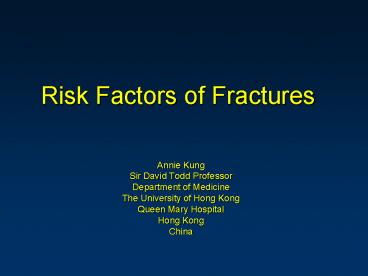Risk Factors of Fractures PowerPoint PPT Presentation
1 / 26
Title: Risk Factors of Fractures
1
Risk Factors of Fractures
- Annie Kung
- Sir David Todd Professor
- Department of Medicine
- The University of Hong Kong
- Queen Mary Hospital
- Hong Kong
- China
2
Osteoporosis Clinical Management
- - Identify patients at risk for osteoporosis-
- related fractures
- provide treatment when needed
- In areas of limited resources, identify subjects
at highest risk of fracture for treatment
3
WHO Definition of Osteoporosis
- A condition characterised by low bone mass and
microarchitectural deterioration of bone tissue,
with a consequent increase in bone fragility and
increase susceptibility to fracture.
1994, WHO Working Group
4
Relative Risk of fracture for a 1 SD decrease
in BMD in women
All
Vertebral
Hip
Forearm
Fracture Site
1.8
1.7
Distal radius BMD
1.4
1.7
1.6
1.8
2.6
1.4
Hip BMD
1.5
2.3
1.6
1.5
Lumbar spine BMD
Marshall D et al, BMJ, 19963121254-1259
5
WHO Diagnostic Criteria for Osteoporosis in Women
Low bone mass
Osteoporosis
Normal T-score gt -1.0 Osteopenia (low bone
mass) -2.5 SD lt T-score ? -1.0
SD Osteoporosis T-score ? -2.5 SD Established
(severe) osteoporosis T-score ? -2.5 SD ? 1
fracture
WHO Study Group. Osteoporos Int 19944368-81
6
WHO Definition of OsteoporosisWhy T score
cut-off at -2.5
T scores lt-2.5 identifies the same percentage of
postmenopausal women with life-time risk of
fracture.
1994, WHO Working Group
7
Prevalence of Osteoporosis and Lifetime Fracture
Risk in White Women
Clinical vertebral fractures
Melton LJ III, et al. J Bone Miner Res.
199510175. Melton LJ III, et al. J Bone Miner
Res. 199271005.
8
How sensitive is BMD in predicting fracture?
9
Absolute Risk of Hip Fracture
- Rotterdam study validated in 5305 people (2227
men/3078 women) - Followed mean 3.8 years (26,771 patient years)
- Number of hip fractures 23 in men, 87 in women
One year hip fracture risk by age and BMD
.05 1-year risk
Men
Women
1.0
.5 1-year risk
Femoral neck BMD (g/cm2)
.8
5 1-year risk
.6
.4
60
90
70
80
Age (years)
DeLaet CE, et al. J Bone Miner Res 1998131587
10
All Non-vertebral Fractures
Hip fractures
11
10-Year Fracture Risk in Swedish Population Age
and BMD
- For a given BMD,
- risk increases with age
Kanis JA et al. Osteoporos Int 200112989-995
12
Fracture Risk is Higher Immediately Following a
Fracture
20 of Patients Will Fracture Again Within One
Year
Lindsay et al. JAMA 2001285320-3
13
History of Fracture Predicts Future Fractures
Klotzbuecher CM et al. JBMR 200015721-39
14
Risk Factors for Osteoporotic Fracture
15
Combined Effect of BMD and Clinical Risk Factors
Rate of hip fracture (per 1000 woman-yr)
No. of risk factors
Calcaneal Bone Density
Cummings S, et al. N Engl J Med 1995332767
16
10-year Probability of Osteoporotic Fracture
(hip, clinical spine, forearm) by BMD T Score and
Country
Kung AWC et al, JBMR 2007
17
10-year Probability of Osteoporotic Fracture
(Hip, Clinical Spine, Forearm) by Age and
Country
Kung AWC et al, JBMR 2007
18
10-year Risk of Osteoporotic Fracture According
to Age and BMD T Score in Hong Kong Chinese Women
Kung AWC et al, JBMR 2007
19
Interaction of Age with Other Clinical Risk
Factors on 10-year Risk of Osteoporotic Fracture
in Hong Kong Chinese Women
Kung AWC et al, JBMR 2007
20
Comparing the 10-year Fracture Risk Prediction
with Clinical Risk Factors with or without
Addition of BMD Measurement in Hong Kong Chinese
Women
Kung AWC et al, JBMR 2007
21
Predicted 10-year Risk of Osteoporotic Fracture
According to Number of Risk Factors and Total Hip
BMD T Score in Hong Kong Chinese Women
Kung AWC et al, JBMR 2007
22
The FRAX? tool has been developed by WHO to
evaluate fracture risk of patients. It is based
on individual patient models that integrate the
risks associated with clinical risk factors as
well as bone mineral density (BMD) at the femoral
neck. The FRAX? models have been developed from
studying population-based cohorts from Europe,
North America, Asia and Australia. In their most
sophisticated form, the FRAX? tool is
computer-driven and is available on this
site. Several simplified paper versions, based
on the number of risk factors are also available,
and can be downloaded for office use. The FRAX?
algorithms give the 10-year probability of
fracture. The output is a 10-year probability of
hip fracture and the 10-year probability of a
major osteoporotic fracture (clinical spine,
forearm, hip or shoulder fracture). This is a
beta version
Dr. John A KanisProfessor Emeritus, University of Sheffield
Links
International Osteoporosis FoundationNational Osteoporosis FoundationJapan Osteoporosis Foundation http//www.iofbonehealth.org/ http//www.nof.org/ http//www.jpof.or.jp/
World Health Organization Collaborating Centre for Metabolic Bone Diseases, University of Sheffield, UK
http//www.shef.ac.uk/FRAX
23
The clinical risk factors used are the following
Age Sex
Weight Height
Previous fracture Parent fractured hip
Current smoking Glucocorticoids
Rheumatoid arthritis Secondary osteoporosis
Alcohol 3 or more units/day Bone mineral density (BMD)
http//www.shef.ac.uk/FRAX
24
http//www.shef.ac.uk/FRAX
25
(No Transcript)
26
Problem with using FRAX in Asia
- Lack of population-specific epidemiology data on
fracture incidence, death rate, health-care cost
in individual Asian countries - Not certain whether the relation between the risk
factors and fracture risk are similar between
Caucasian and Asian populations - Use of NHANES III Caucasian female database for
Asian women and men

